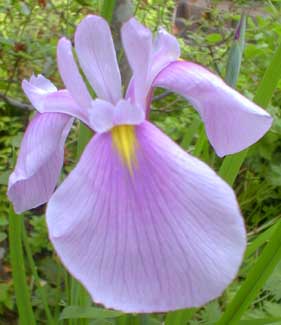
'Rose Queen'
Rabbit-ear Iris
or Japanese Water Iris
"Gushing from the mouths of stone men
To spread at ease under the sky
In granite-lipped basins,
Where iris dabble their feet
And rustle to a passing wind,
The water fills the garden with its rushing."
-Amy Lowell
(1874-1925)
(1874-1925)
Iris laevigata aka I. ensata 'Rose Queen' is a pale pink to lavender-pink iris with darker rose-pink stripes on the falls. It is regarded as the first true pink Japanese iris ever bred, though I think it can be argued how "true" the pink vs how lilac the color really is. It is thought likely to have been developed from a pink strain originating in Sibera, as the Siberian sub-races have broader falls & so does 'Rose Queen.'
Japanese water irises are sometimes called rabbit-ear irises or sump sword lily. In Japan they're called Kakitubata, a name which alludes to its usefulness in dye-making. It is native of a broad sweep of Asia, from Japan, Taiwan, Korea, China, & Russia.
The species is not very drought tolerant & need regular moisture, not too wet. It can go longer between waterings if the rhizomes are shaded, but the leaves want sunlight. It will also thrive in bog conditions. They would naturally grow on riverbanks above the waterline & don't really prefer to have their roots totally submerged, but will tolerate some very boggy conditions. It may stunt & spread slowly in a shallow pond.
We planted a very slender rooted start of 'Rose Queen' without much rhizome developed, near a western azalea that also likes somewhat persistent moisture. For two years it did very little, but on the third year the sword-leaves rose up to two feet or higher, & bloom stocks higher still. Each bloom is a good three inches high & wide, or a little larger. It thereafter spread rapidly by creeping rhizomes.
'Rose Queen' can flower at any time from May to August & in our garden is at its height in June.